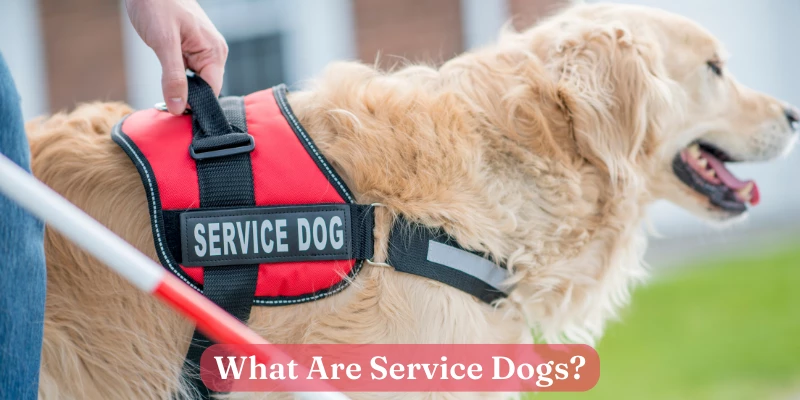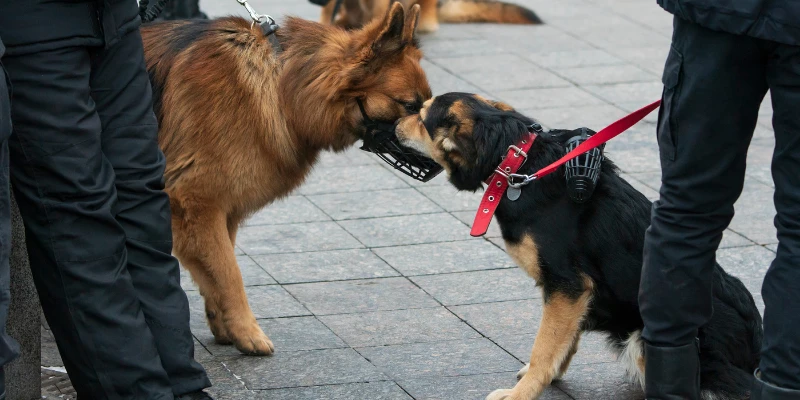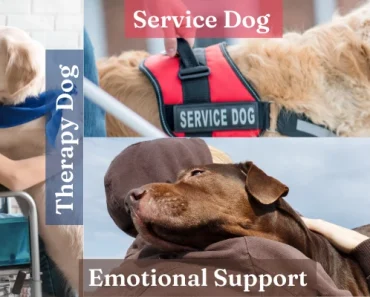I hope you are ready to learn all about service dogs!
I am going to dive deep into the subject and provide you with tons of information about what service dogs are.
I’m also going to discuss the different types of service dogs, what those types are trained to do, where service dogs are allowed in public, and lots more.
Learn everything that you need to know about service dogs.
Find out what the differences are between service animals and emotional support animals.
Learn what you need to identify your dog as a service dog and more.
No need to waste time, there’s lots to cover so let’s first define the definition of a service dog.
What Are Service Dogs?
Service dogs are defined under the U.S. Department of Justice by the “Americans with Disabilities Act”. This Act defines service dogs as animals that have been trained to assist the disabled by performing certain tasks or doing specific work – which helps disabled people be a part of regular society.
A dog is not considered a service dog unless it has the proper training to help with the disability of the person it will be servicing in a public, government, or state facility.

The tasks or the work performed by the service dog must be directly related to the person’s disability for the dog to be considered a service dog.
The dog must also be trained to perform these tasks or work to qualify as a service dog.
The ADA requires local government and state agencies to allow entry of people with disabilities and their service dogs.
The ADA also requires any place that provides services and goods to the public to allow entry of disabled people and their service dogs.
This includes most stores and public gatherings, but it is always best to check with the local entity before visiting just so you understand their policies and aren’t turned away when you visit.
The Purpose of Service Dogs
The purpose of a service dog is to help a person with a disability by doing certain tasks or work that assist the person with the disability and allows them to be a part of regular society.
Before I first started researching service dogs, I mainly thought most were emotional support dogs and dogs that lead the blind.
But I was unaware that emotional support dogs are a different category, which I will talk about in the next section of this article.
There are different types of service dogs to help with a variety of disabilities (mental & physical).
Types of service dogs include: guiding a blind person when they are in public, alerting a deaf person of someone approaching in public, picking something up for someone, and bringing it to them when they are confined to a wheelchair, keeping a person safe when they are having a seizure and many more.
However, I would like to note that emotional support dogs aren’t considered service dogs.
Service dogs and emotional support dogs are put into two separate categories and don’t have the same regulation by the ADA.
Difference Between Service Dogs & Emotional Support Dogs
Service dogs are defined as dogs that have been trained to perform certain tasks or work to help disabled people carry on with their daily lives.
This means that to be classified as a service dog, the dog must perform some action based on its training to help a person with their disability.
Emotional support animals are labeled as dogs or other animals that can be used for emotional support and/or companionship.
These animals typically don’t have any training to perform the same tasks or work a service dog would be trained to do since their main job is comfort and emotional support.
Emotional support can be to help a person with anxiety or to provide comfort to a person just by being present and not doing anything in particular with no required training.
That said, there can be a thin line between what is considered an emotional support animal compared to what is considered a service animal.
The lingo can be a bit confusing when determining if a dog should be considered an emotional support animal or a service animal.
The determining factor that distinguishes a service dog from an emotional support dog is that a service dog has been “trained for tasks or work” while an emotional support dog has not.
For example, if a dog has been trained to detect when someone is about to have an anxiety attack and to perform a certain action to prevent or lessen the anxiety attack, it would be considered a service dog.
If a dog is just there to provide comfort while a person is having an anxiety attack with no formal training to perform a task or work, it is considered an emotional support dog.

11 Different Types of Service Dogs
A service dog is labeled as a different type based on the training the dog has received for the disability or disabilities it will assist with.
Below are 11 of the most common types of service dogs.
Some types can be grouped as one type, but I sub-divided some of the types for further explanation.
1. Allergy Detection Dogs
Dogs identified as allergy detection dogs are used to sniff out certain odors that correspond to certain allergies in people, such as peanuts, gluten, and other odors.
These dogs are typically paired with kids that have allergies to alert them whenever they smell odors that they were trained to sniff out to ensure the human they accompany doesn’t ingest something they are allergic to.
2. Autism Assistance Dogs
Dogs identified as autism assistance dogs are trained to keep track of children on the autism spectrum.
These dogs can deter children from running off and can track them if they do run away.
A dog trained to be with an autistic child can also provide a sense of comfort and help ease the child into social settings.
This can help the child be more social, help provide better social experiences for the child and help the child not be so isolated.
3. Diabetes Alert Dogs
These service dogs are trained to alert people when their blood sugar levels are becoming too low or too high.
Diabetes Alert Dogs also referred to as DADs, are trained to smell hypoglycemic scent changes in people.
While we as humans can’t determine scent changes, dogs trained to sniff out the scent can determine when the scent changes, then alert their humans to let them know it is time to check their blood sugar level before it becomes too high or too low.
4. FASD Support Dogs
Fetal alcohol spectrum disorders, or FASD, develop in some children exposed to alcohol prenatally.
Disorders included can be anything from physical and mental disabilities to behavior and learning issues.
FASD support dogs can be trained based on the needs of the child and their disability.
This can be to help with physical and mental issues such as comfort or to help prevent repetitive behavioral issues.
5. Guide Dogs
Guide dogs are dogs that are trained to guide the blind and visually impaired when they are moving about in their daily lives.
Guide dogs are one of the first types of service dogs that started the movement for service dogs to be allowed to accompany people with disabilities.
Guide dogs will typically have a special harness with a handle on the end of it for the blind or visually impaired person to hold on to as the dog guides them around obstacles and to their destination.
6. Hearing Alert Dogs
Hearing alert dogs are trained to alert their deaf handler when there is a noise heard that they need to respond to.
Common noises these service dogs can be trained to respond to include the ringing of a doorbell, a baby crying, various types of alarms, and other sounds.
These dogs are trained to touch or nudge their person when they hear a sound they’ve been trained to respond to.
Upon touching the person, the service dog is typically then trained to lead or guide the deaf person to the source where the noise came from.
Hearing alert dogs can also be trained to alert deaf people when someone is approaching them from behind while they are out in public.
7. Mental Health Alert Dogs
Dogs trained to assist those with mental health problems can help people with depression, panic attacks, anxiety disorders, and more.
You may also hear these dogs be called psychiatric service dogs.
PTSD and autism dogs fall under this category, but those are more in-depth, so I listed them separately.
Some mental health service dogs can be trained to remind their human to take their medication when it is time.
8. Mobility Assistance Dogs
Mobility assistance dogs are dogs that are specifically trained to help people that are bound to a wheelchair or people that have limited mobility.
These dogs can be trained to do anything from close doors to pick up things for their human.
These dogs can also be trained to pull wheelchairs and open and close drawers, refrigerators, and more.
The purpose of these dogs is to help their limited mobility humans maintain independence in their everyday life with the assistance of the dog.
9. PTSD Dogs
PTSD stands for Post Traumatic Stress Disorder. This is commonly seen in some veterans that have experienced traumatic events during the time of war.
But this can also apply to other types of traumatic stressors that people have experienced in their life such as car accidents, abuse, natural disasters, and other life-changing events.
A PTSD service dog can be trained to help a person suffering from PTSD by entering the home before the person to ensure a sense of relief from the person.
It is a way for the dog to make sure all is safe before the person enters. The dog can also be trained to turn on lights using a special foot pedal and more.
In public, PTSD dogs can help keep a person calm by creating a barrier between the person and other people in public.
This can provide a sense of relief from the person and give them the personal space they need to feel comfortable in public.
10. Seizure Alert Dogs
While there is no evidence that dogs can predict when a seizure is about to happen, there is a small number of dogs that can supposedly be trained to react in a certain manner right before someone is about to have a seizure.
Although there is no evidence or studies conducted to prove there are dogs that can detect a seizure before it happens, many people insist their dog has accurately predicted and alerted right before a seizure took place.
This is a controversial type of service dog, to say the least.
Many experts state that a dog can’t know when a seizure is about to happen, but many trainers and owners have stated that it is possible and that they’ve experienced success with their dogs accurately predicting the onset of a seizure.
11. Seizure-Responsive Dogs
Seizure alert dogs are trained to alert before a seizure begins, but seizure response dogs are trained to take action when their owner has started experiencing a seizure.
These dogs can be trained to perform many different tasks such as barking for help, sounding an alarm system during the seizure, keeping the person safe while they are having the seizure, and even bringing medicine or a phone to a person that is recovering from the seizure.
Where Are Service Dogs Allowed?
Per ADA guidelines, service dogs are allowed in local government and state facilities, as well as, any area of the public where people are allowed to shop or gather.
This includes public places such as public transportation, public schools, retail stores, restaurants, hospital waiting rooms, and others.
Service dogs are also allowed to live with their handlers because landlords can’t discriminate against disabilities and service dogs even if they have a no-pet policy.
However, there is more to it than that.
Handlers may need to present appropriate documentation about their disability and why they need a service dog, but landlords can’t necessarily deny a person residency based on that person having a service dog.

Where Are Service Dogs Banned?
This just depends on whether the place is considered a public place or not. For example, a service dog is permitted in a restaurant but wouldn’t be allowed in the kitchen.
But then again, patrons wouldn’t be allowed in the kitchen either, so most of it should be common sense when you are visiting.
Other examples of where a service dog wouldn’t be allowed would be operating rooms in hospitals, private clubs, places where people worship, etc.
It is always best to call ahead to a place you plan to visit and see what accommodations they have for a person with disabilities and their service dog.
Can Employees Ask About Service Dogs?
Employees are only supposed to be allowed to ask you two questions to determine if your dog is a service dog. The two questions are as follows:
- Is the dog a service animal that is required because of a disability or disabilities that you have?
- What specific work or tasks has the dog been trained to perform for the disability or disabilities that you have?
Employees shouldn’t ask anything but those two questions.
However, you may find that many employees and establishments are misinformed or don’t abide by the ADA regulations and may ask other questions or for proof and identification for your service dog.
What Is Service Dog Fraud?
Service dog fraud is when a person uses a pet dog as a service dog when the dog hasn’t had the proper training to be a service dog.
In other words, a person takes their pet dog to a place where only service animals are allowed and the person tries to pass their dog off as a service dog when the person knows the dog had no proper training to be labeled as a service dog.
In some states, this is punishable as a crime and comes with a hefty fine.
While employees are only able to ask you the two questions above, I can’t predict how the establishment will decide which dog is a service dog and which one is not based on those two questions.
So it is best to ensure your dog can do the proper tasks or work it is supposed to be able to do since that is one question they are allowed to ask when you enter their establishment.
How to Identify Service Dogs
As stated earlier, there is no specific paperwork or certification required for a service dog.
So technically, there is no real verifiable way to determine service dogs from pets.
Service dogs should be well-trained and well-behaved in public and will typically have vests on, but some may not be so easily identified.
Do Service Dogs Wear Vests or Other Identifying Markers?
No, there isn’t any specific requirement for a service dog to wear a vest but it is best practice to get a vest for your service dog.
However, there is no law or policy stating that your service dog has to wear a vest or other identifying markers of any kind.
I say it is best practice to have a vest for your service dog because even though there is no requirement to have a vest or documentation for your service animal, some establishments may still want you to prove or identify your dog as a service dog.
Even though they are supposed to only be allowed to ask you the two questions I mentioned earlier, some may be misinformed and want you to provide some type of proof for your service dog.
To avoid this hassle, just purchase a cheap vest and get some type of identification card for your service dog.

Best Practices for Service Dogs in Public
- A service dog should always be restrained with a leash, tether, or harness when out in public unless that restraint impedes the dog’s ability to perform its tasks or work.
- A service dog should be well-mannered and behave properly in public without getting distracted by everything that goes on in public places.
- A dog should be trained to perform the tasks or work to assist in the disability of the handler when out in public.
- A service dog should be under the control of the handler at all times while in public (no wandering off).
Filing Complaints When Service Dogs Are Denied Access
Per federal law, all states have established agencies to defend the rights of individuals with disabilities.
If you or someone you know has been denied access and you believe you have or the person you know has the right to visit the establishment with their service dog, you can contact one of these agencies to investigate the issue and see if there is a solution to the problem.
Understanding the rights of disabled people and their service dogs is very important for disabled people and the public.
Unfortunately, I don’t believe there is enough emphasis placed on these rights with establishments and their employees.
Just know your rights and where you are allowed to go so there is no confusion.
Call ahead to the establishment to see what their policies are and what they require if they allow service animals.
To file a complaint with the ADA, you can visit their website here to see the requirements.
Recap
This article gave you tons of information about service dogs.
You should now know what service dogs are, the different types of service dogs, where they are allowed and banned, and so much more.
I always strive to provide as much information in my articles as possible about the subject I’m discussing.
I hope this article was able to give you the information you were looking for about what service dogs are, how they should be represented in public, and the various types of tasks these dogs are trained to perform.
I have written other articles about where pet dogs are allowed access and how to get your dog trained as a service dog.
If you are interested in reading either of those articles, check them out below.
Other Articles I’ve Written About Service Dogs
- Are Dogs Allowed in Walmart? Home Depot? 40 Dog-Friendly Stores
- How Do You Register or Train Your Dog to Become a Service Dog?
- 12 Tips to Spot a Fake Service Dog or Poorly Trained Dogs
- Differences Between Service Dogs, Emotional Support Animas, & Therapy Dogs
References





